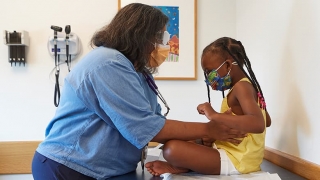Pertussis Precautions for Professionals
Pertussis is an afebrile respiratory illness caused by the bacterium Bordetella pertussis. It is highly contagious and occurs in all age groups. Pertussis is spread by respiratory droplets generated through coughing, sneezing and even talking. People with pertussis usually spread the disease while in close contact with others, who then breathe in the bacteria.
An infected person is most contagious early in the course of illness. After pertussis exposure, patients become contagious when symptoms develop. If left untreated, an infected person can spread pertussis for up to three weeks after symptoms begin. The attack rate (percent of those exposed who actually get the disease) among unimmunized household contacts is 90 percent.
Although the vaccine is effective, immunity is incomplete and wanes over time. Therefore, anyone can contract pertussis infection. People who have been previously immunized are more likely to have milder symptoms, although they are still highly contagious. In a vaccinated child or adult, pertussis can mimic other cough-related illnesses.
When to suspect pertussis
Pertussis should be suspected in any patient with a cough illness with no or mild fever, particularly if cough has persisted for more than one week. Additional key signs and symptoms include:
- Paroxysmal cough and/or post‐tussive vomiting or whoop
- Apnea or cyanosis without the characteristic paroxysmal cough, especially in infants
- Refractory reactive airway disease/asthma with prominent cough
- Sweating between cough episodes in adolescents and adults
- A cough illness of any duration and a known close exposure to a pertussis case
Pertussis testing instructions
- Bordetella pertussis PCR is the test of choice for laboratory confirmation
- CHOP LAB ORDER: Bordetella Pertussis DNA (PCR)
- For Quest PA ORDER: Bordetella pertussis/parapertussis PCR
- For Quest NJ ORDER: B. Pertussis/parapertussis DNA 11365X
- For Lab Corp ORDER: Bordetella Pertussis and Bordetella Parapertussis Real‐time DNA PCR
- PCR is most sensitive within three weeks after cough onset, but can be sent at any time while the patient is still symptomatic.
- Do not send a culture. Do not send antibody studies.
- View a demonstration of proper collection procedures.
- REMEMBER: A mask and new gloves must be worn during specimen collection.
- False positive results can occur: DO NOT SEND a PCR on asymptomatic patients.
Precautions that help limit disease transmission
- Any patient with an afebrile respiratory illness and prolonged cough greater than one week should wear a mask in the waiting room.
- Wearing a surgical mask within 3 feet of the patient provides protection from the spread of pertussis. Often times, close household contacts are the source of the child’s infection; therefore, providers should also wear masks when within 3 feet of symptomatic parents or siblings.
- Antibiotic prophylaxis (azithromycin) should be given to ALL household and close contacts, including potentially exposed healthcare workers, regardless of vaccination status. Prophylaxis is most effective within 21 days of cough onset in the index case but should still be considered if there are infants or pregnant women in the household.
- If you have been exposed to pertussis at work, please contact Infection Prevention and Control with the name of the patient, date of exposure(s) and any names of other healthcare workers who you know were exposed. Infection Prevention and Control will forward your information to Occupational Health, who will provide you with prophylaxis if you have been exposed to a confirmed case of pertussis.
- With PEP, we are relying on drug levels to prevent establishment of infection. Since azithromycin remains in the system at therapeutic levels for 10 days following initiation of treatment, if repeat exposure occurs within 10 days of starting the medication (i.e. within five days of completion of five‐day course), then no additional PEP is indicated.
- If repeat exposure occurs after 10 days of starting the medication (i.e. after five days of completion on five‐day course), then repeat PEP is needed.
Reviewed by: Julia Shaklee, MD, MSCE, Associate Hospital Epidemiologist and Medical Director
Date: August 15, 2012

